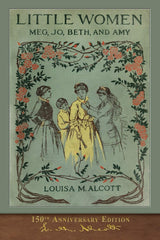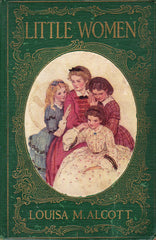Story Skeleton—Little Women

Story structure relates to the psychological appeal of narrative, that which engages readers and builds in them a sense of anticipation—a desire to know what happens next. This blog series is meant to demonstrate the universality of story structure with plot breakdowns of award-winning and classic novels.
Jo's Compromised Arc
By Katie Zdybel
On the surface, Little Women by Louisa May Alcott seems like a straightforward bildungsroman, or coming-of-age story, which follows the mostly charming lives of the four March sisters: Jo, Meg, Amy, and Beth. The novel’s 47 chapters link together episodes in the girls’ lives concerning their artistic endeavours, their self-education, their loyalty and love for each other, their other family relationships, friendships, and love interests, and the development of their values and moral integrity. The structure seems simple too—in Part One, we follow them chronologically for a year from Christmas to Christmas, beginning when Meg is 16, Jo 15, Beth 13, and Amy 12. When we enter Part Two, we find that three years have passed since the ending of Part One, but then we dive back in, following along closely, each chapter covering a month or so, emulating the pattern for the passage of time set in Part One.

But if we take a closer look at Little Women, and place it in the context of its time, we can see that structure was a very complicated problem for Alcott. There are two reasons for this: first, structure is formed on the basis of understanding narrative motivation, and not only did Alcott have four protagonists’ motivations to resolve, they were all women. And second, when she started Little Women, she intended to end it with Part One. It was only after the unexpected success of the first volume that she went on to write a second volume (called, ironically, Good Wives), which later was printed together with the first volume to create the collective work we now think of as Little Women.
Coming back to the first problem—of having a group of female protagonists—we can still apply Hannah Sheppard’s pitch test in order to find the narrative motivation:
When A (inciting incident) happens, B (character) must do C (action) otherwise/before D (catastrophe).
Let’s look at each of the March sisters through this lens:
When Meg begins developing feelings for John Brooke, the poor tutor, she must decide whether to pursue her desire to marry rich or follow her nobler intentions of marrying for love and leading a good and simple life in order to determine what kind of person she wants to be.
When Jo grows up and her sisters all begin moving on, she must pursue her writing career and expand upon her independence, otherwise she will settle for a life that doesn’t satisfy her.
When Amy goes to Europe to study painting and comes to the decision that she has only average talent, she must choose another way of getting the life she wants before she loses any chance to secure fulfillment for herself.

Beth is an interesting character to study for motivation because all she really wants is for the family to be together and to do good for others. She loves playing the piano, but has no ambition for success or attention. After she becomes sick with scarlet fever, she seems to accept that she won’t live long, and exists in a kind of childlike dream world where all that happens, good or bad, seems to be calmly, sagely accepted by her. In this way, she serves as a foil to the other three protagonists, who all desperately want something: Meg to have a life of beautiful things, Jo to be a writer, Amy to be a painter or to marry rich.
The gender issue related to structure arises when we put this novel in context. Written in 1868 (and set in 1861 and onward), storylines for women were expected to follow a standard romantic arc, in which a women meets a respectable man at the beginning of the story and by the end they are married. Married or dead, as the editor, Dashwood, in Greta Gerwig’s recent film adaption of Little Women famously tells Jo March. This is worth taking into account because it would have been exactly what Alcott was expected to deliver for each of her four protagonists.
With Meg, who desires to be wealthy and good, and Amy, who desires to be self-sufficient in one of few ways women were able to be so in that time—by marrying rich—this was less complicated; both Meg and Amy end up marrying in Part Two (and the contrast between Meg’s marriage into poverty and Amy’s into wealth is a study in how marriage was an economic decision for women of this time, not a romantic choice). Beth has no love interest throughout the novel, and dies young, satisfying Dashwood’s mandate in the more tragic way. And Jo, perhaps the true protagonist as her character is most vivid on the page and we feel her desire more than the others’, wants desperately to be a writer and states multiple times that she has no interest in becoming a wife.
Jo's friendship with Laurie, the fun-loving, mischievous, sweet-natured boy next door provides some dramatic tension in that readers might hope for Jo to fall in love with him. It becomes clearer as the novel goes on that Laurie has feelings for Jo, but ultimately, when Laurie proposes, Jo refuses. This was a bold move for Alcott, who was feeling the pressure from readers and publishers to marry off all the girls. In fact, Alcott wrote in her journal in 1868, “I won’t marry Jo to Laurie to please anyone.” (Emphasis is Alcott’s)
Ironically, at the end of the second volume (or Part Two), which Alcott wrote to appease fans’ appetite for more, she marries Jo off to a new character, Professor Bhaer, who is introduced in the second half of the book. Again, it’s worth considering how Gerwig—who studied not only all of Alcott’s published works but also her unpublished journals—handled this in her film adaptation: she allows Jo and Dashwood to discuss how she prefers not to marry her protagonist off, to which the editor replies that a marriage at the ending will sell better.

In the novel, it’s straightforward: Jo and Bhaer confess their love for each other and open a school for boys. In the film, Gerwig plays with the idea that Jo (and Alcott) might have written into their novels a romantic ending to suit male expectations, but ultimately, we are shown that Jo’s true victory at the end is that her book is published. Her happy ending has little to do with romance and everything to do with pursuing her passion. This is not the ending Alcott had the liberty to present in her novel.
So, we’re faced with a contradiction: Part One sets us up to believe that Jo’s narrative motivation is to become a writer and independent woman, but the ending of Part Two acts as though she wanted to find love all along (which is not supported throughout the book). We could call this a weak narrative arc, or we could consider the time in which the novel was written and call it a compromised arc.
For the sake of sketching the story skeleton with the arc that offers the most narrative increments, let’s take Jo’s pursuit of writing as her motivation, and break down the plot points of the novel Little Women:
Stasis
Jo is content with her family life, living in a modest home in small-town Massachusetts in 1861 at the beginning of the Civil War. While their father serves in the war, the March sisters pull together to earn income, take care of each other and their home, all while creating a life full of exceptional creativity and warmth in the way that they work and play together.
Inciting Incident
As the girls grow up, Jo’s desire to become a writer grows stronger. Motivated to earn an income for her family (who struggles financially) and determined not to marry, Jo moves to New York and tries to get her stories published.
Point of No Return
Jo is further pushed in this direction when her closest friend, Laurie, develops feelings for her (which she does not return).
Rising Action
• Beth becomes sicker, which worries Jo as she and Beth are particularly close.
• Jo receives criticism for her story and takes Beth to the sea to try and help her recuperate from her illness.
• Jo, who has been expecting Aunt March to take her to Europe, learns that Amy will go instead. This is devastating to Jo, who has a hunger to see the world.
• Jo meets Professor Bhaer who later criticizes the kinds of stories she is writing in New York.
• Jo rejects Laurie’s marriage proposal.
All is Lost
Jo returns home and confesses that she feels frustrated, watching her sisters move on from childhood into fuller, richer lives.
Resurgence
Professor Bhaer comes to see Jo in Massachusetts. They admit their feelings for each other.
Climax
Jo and Bhaer open a school for boys. Jo has given up her writing career and prepares to be a teacher and a mother.
Arc
It’s interesting to consider how Alcott may have completed Jo’s arc were she given artistic freedom to write as she pleased. For years, readers have questioned Jo’s decision to give up her writing and marry Bhaer at the end of the novel. In the film, Gerwig experimented with the arc, giving it the ending she believed Alcott would have wanted had Alcott’s publisher not interfered.
As it stands, the resolution may feel satisfying to some, and confusing or incomplete to others: Jo, an independent and creative young woman, dreams of becoming a writer, writes plays and stories throughout her childhood, then moves to New York to begin publishing on a larger platform, and finally, gives up her writing career and marries a teacher with whom she opens a school for boys.
In Conclusion

Even today, domestic stories that follow the quiet lives of ordinary women and their work and friendships are often considered unpublishable. In order to sell, plots are thickened, dramatic embellishments heightened, and, in the end, we still expect the woman to have some sort of satisfying conclusion in her romantic life.
Alcott lived during a time when it would have been impossible for her to have full creative freedom from her male publishers. She had to make creative decisions by weighing her economic risks—and as a woman, she had very few opportunities for earning income. It would have destroyed her career to stand up to her publishers and insist that Jo March needn’t find romance in her novel. For this reason, we have to consider Alcott’s true intentions when we study her novel’s story skeleton. As filmmaker Greta Gerwig did, we can look closely at Alcott’s journals, other writing and works of fiction, in order to puzzle together how Alcott truly felt about Jo March’s narrative arc.

Katie's first collection of short stories, titled Equipoise, was shortlisted for the 2018 HarperCollins | UBC Prize for Best New Fiction. She is the recipient of a 2019 and 2021 Canada Council for the Arts award, the Peter Hinchcliffe Short Fiction Award, the Carter V. Cooper Short Fiction award, and was publisher-nominated for a Journey Prize as well as two National Magazine Awards in fiction. Katie is an assistant editor at Narrative Magazine, and has worked on PRISM International’s editorial board. As a manuscript editor, she enjoys working with character, theme, and imagery.






